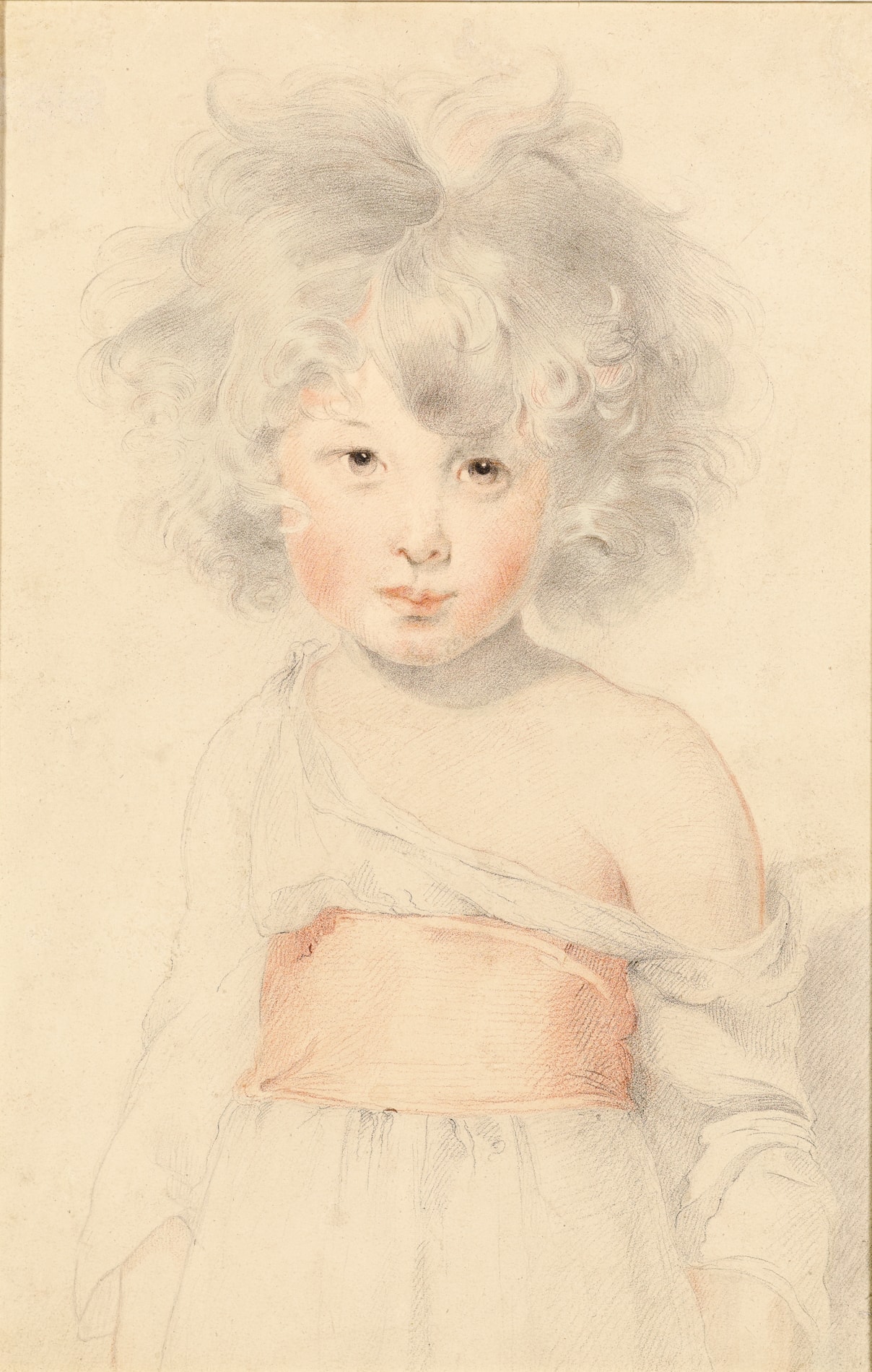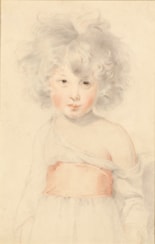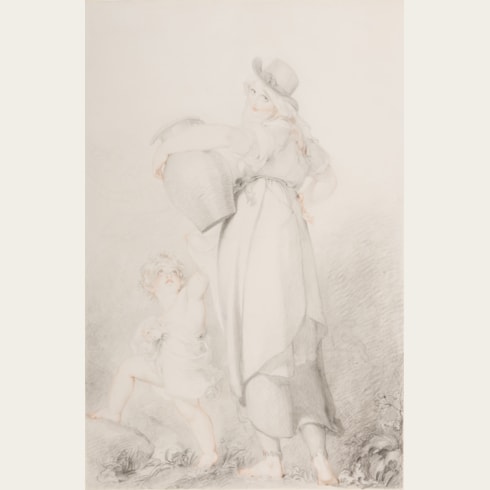Thomas LAWRENCE
(Bristol 1769 - London 1830)
Portrait of Master Charles Malton
Sold
Pencil, with red and brown chalks.
Traces of an inscription in brown ink at the extreme lower left.
Inscribed Charles Malton / Lawrence on the verso.
293 x 194 mm. (11 1/2 x 7 5/8 in.)
ACQUIRED BY THE PRINCETON UNIVERSITY ART MUSEUM, PRINCETON, NJ.
Traces of an inscription in brown ink at the extreme lower left.
Inscribed Charles Malton / Lawrence on the verso.
293 x 194 mm. (11 1/2 x 7 5/8 in.)
ACQUIRED BY THE PRINCETON UNIVERSITY ART MUSEUM, PRINCETON, NJ.
Thomas Lawrence was particularly admired for his portraits of young children, whom he depicted with great sensitivity and charm. Kenneth Garlick has observed that ‘Lawrence was noted for his success not only in drawing children but also in identifying with them. They loved him, and his quick, sympathetic eye could catch their movements to perfection.’ This striking drawing is a portrait of the young Charles Malton, born in 1788 and the son of the scene painter and architectural draughtsman Thomas Malton the Younger (1748-1804). In later years, Charles Malton would study architecture with Sir John Soane. Although he won a silver medal for architecture at the Royal Academy in 1807, there is no evidence that the younger Malton ever worked as an architect.
Many of Lawrence’s portrait drawings, and especially those of children, were reproduced as prints, often at the artist’s instigation. For much of the last two decades of his career, Lawrence commissioned the engraver Frederick Christian Lewis (1779-1856) to reproduce many of his finest portrait drawings in the form of stipple engravings, both to serve as a record of them and also as a means of disseminating his most significant and appealing works to the public at large. Lewis was to be occupied almost exclusively on prints after Lawrence’s work until the artist’s death in 1830. The present sheet was one of those later reproduced by Lewis, with the stipple engraving published by Colnaghi in 18315. The print bears the inscription ‘A Portrait / by Sir Thomas Lawrence PRA at the Age of 20 / from the original drawing in the possession of Charles Malton Esqre.’
This drawing was once in the collection of the English art dealer and collector Edwin Marriott Hodgkins (1860-1932), who worked from premises in London, Paris and New York, and was exhibited by him in his New York gallery in 1911. In the same year Hodgkins presented a small group of seven English drawings from his collection to the Louvre, including works by Richard Cosway, John Downman and Lord Leighton, as well as one drawing by Lawrence; a portrait of Charlotte Augusta, Princess of Wales.
Many of Lawrence’s portrait drawings, and especially those of children, were reproduced as prints, often at the artist’s instigation. For much of the last two decades of his career, Lawrence commissioned the engraver Frederick Christian Lewis (1779-1856) to reproduce many of his finest portrait drawings in the form of stipple engravings, both to serve as a record of them and also as a means of disseminating his most significant and appealing works to the public at large. Lewis was to be occupied almost exclusively on prints after Lawrence’s work until the artist’s death in 1830. The present sheet was one of those later reproduced by Lewis, with the stipple engraving published by Colnaghi in 18315. The print bears the inscription ‘A Portrait / by Sir Thomas Lawrence PRA at the Age of 20 / from the original drawing in the possession of Charles Malton Esqre.’
This drawing was once in the collection of the English art dealer and collector Edwin Marriott Hodgkins (1860-1932), who worked from premises in London, Paris and New York, and was exhibited by him in his New York gallery in 1911. In the same year Hodgkins presented a small group of seven English drawings from his collection to the Louvre, including works by Richard Cosway, John Downman and Lord Leighton, as well as one drawing by Lawrence; a portrait of Charlotte Augusta, Princess of Wales.
The leading portrait painter of his generation in England, and indeed arguably in Europe, Sir Thomas Lawrence was, from his early childhood, recognized as a brilliant and gifted draughtsman, and it was through his drawings that he established his initial reputation. (When he first exhibited at the Royal Academy in 1787 he showed a total of seven works, all of which were drawings or pastels.) Indeed, his abilities as a draughtsman are all the more notable in that it was a skill in which he was, for the most part, self-taught.
The importance of drawing in Lawrence’s artistic process throughout his career cannot be overstated. He began each portrait painting by drawing in oiled black chalk on the canvas, and also created a large number of both preparatory studies and autonomous portrait drawings, deftly executed in red and black chalks. As Cosmo Monkhouse noted of Lawrence, ‘As a draughtsman, especially of faces and hands, he is scarcely equaled by any English artist…His most perfect works are his drawings in crayon and pencil, which he continued to execute throughout his life.’ More recently, Michael Levey has further noted of the artist that, ‘It is not just that Lawrence had been profoundly trained – self-trained – as a draughtsman and that he continued to draw expertly throughout his life. For him, drawing was the method by whereby he pinned down his prime visual sensations.’
Lawrence’s ability as a draughtsman continued to be praised long after his death. Writing in 1913, one noted art critic wrote that, ‘Of the many who admire Sir Thomas Lawrence, as one of the most individual and fascinating of English portrait painters, few realise that he was greater with the pencil than with the brush; and that the grace and elegance which characterise his art are more superbly expressed in the delicate tints of water-colour than in the heavier, more solid, and more opaque oil pigments…Lawrence thought in pencil what he expressed in oil. Unlike his great contemporaries and predecessors, he found it necessary to make elaborate drawings from his sitters before setting down their likeness in color. Thus it is almost only in his drawings that he attained that perfect ease and spontaneity of expression which is the hall-mark of a great master.’
It has been noted that, among Lawrence’s contemporaries, perhaps only Jean-Baptiste-Dominique Ingres in France may be said to have been his equal as a draughtsman in the delicacy and precision of his technique. It was also Lawrence’s close study and appreciation of the great draughtsmen of the past that led him, once he had achieved considerable success, to assemble one of the finest collection of Old Master drawings ever put together in Britain.
Provenance
Thomas Malton the Younger, London
By descent to his son, Charles Malton (the sitter)
Edwin Marriott Hodgkins, London and Paris, by 1911
His sale, London, Christie’s, 29 June 1917, lot 67 (unsold at 160 gns.)
Anonymous sale, Paris, Galerie Charpentier, 24 May 1955, lot 129.
Literature
Algernon Graves, ‘A Catalogue of the Exhibited and Engraved Works of Sir Thomas Lawrence, P.R.A.’, in Lord Ronald Sutherland Gower, Sir Thomas Lawrence, London, 1900, p.148; George Somes Layard, ed., Sir Thomas Lawrence’s Letter-Bag, London, 1906, engraving illustrated facing page 70; ‘The American Collector and Connoisseur: A Collection of Early English Drawings of the 18th Century’ [editorial], Arts & Decoration, January 1912, p.111; Sir Walter Armstrong, Lawrence, London, 1913, p.185 (‘Malton, Charles. Son of Thomas Malton, the architectural painter...Chalk drawing. Boy of 6 or 7. Standing, facing, nearly full face. Enormous shock of hair. Signed “T. Lawrence, April, 1790.”’); Kenneth Garlick, ‘A catalogue of the paintings, drawings and pastels of Sir Thomas Lawrence’, The Walpole Society, Vol.XXXIX (1962-1964), 1964, p.236; Phillip H. Highfill, Jr. et al, A Biographical Dictionary of Actors, Actresses, Musicians, Dancers, Managers & Other Stage Personnel in London, 1660-1800, Vol.10, Carbondale and Edwardsville, 1984, p.66.
Exhibition
London, Royal Academy, 1791, no.516 (as Portrait of a Child); New York, Hodgkins Galleries, A Collection of Early English Drawings of the 18th Century, 1911.






